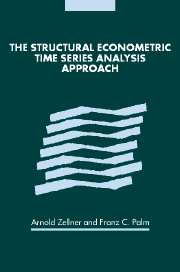Introduction
Published online by Cambridge University Press: 24 October 2009
Summary
In the early 1970s we were concerned about the relationships between multivariate and univariate time series models, such as those brilliantly analyzed by Quenouille (1957) and Box and Jenkins (1970) and multivariate dynamic structural econometric models that had been and are widely employed in explanation, prediction and policy-making. Fortunately, we discovered the relationships and reported them in our paper, Zellner and Palm (1974) that is included in part I of this volume (chapter 1). See also the other general chapters in part I discussing general features of our approach, the reactions of leading researchers, and many useful references to the literature.
Having discovered the algebraic relations connecting statistical time series and structural econometric models, we next considered how this discovery might be used to produce improved models. In this connection, we thought it important not only to emphasize a philosophical preference for sophisticatedly simple models that is discussed in several chapters in part I and Zellner, Keuzenkamp, and McAleer (2001), but also operational techniques that would help researchers actually produce improved models. As illustrated in the chapters included in this volume, our approach involves (1) deducing algebraically the implied marginal processes and transfer functions for individual variables in a multi-equation model, e.g. a vector autoregression (VAR) or a structural econometric model (SEM), and (2) comparing these derived equations' forms and properties with those derived from the data by use of empirical model identification and testing techniques.
- Type
- Chapter
- Information
- The Structural Econometric Time Series Analysis Approach , pp. xiii - xviPublisher: Cambridge University PressPrint publication year: 2004



